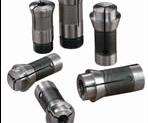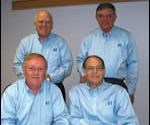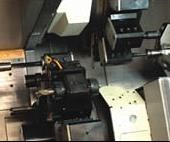Workholding For Swiss Turning
In large part, because of the machine’s versatility, Swiss turning is increasing its penetration of the precision turned parts market. As more shops look to this technology, a look at workholding considerations is in order.
Once I got past Erie, Pennsylvania, and onto I-86, formerly the Southern Tier Highway, the drive to Elmira, New York, was absolutely beautiful. Lush, rolling hills with a median strip so wide that it often seems like my two lanes are exclusive. An added bonus was the trees were beginning to turn. I recently made this trip on a sunny, warm, early fall day to visit with Hardinge, Inc. (Elmira, New York) to talk about workholding for Swiss turning applications.
Any metalworking process is a series of discrete technologies that must function as a system to successfully manufacture quality parts. In Swiss turning, the process involves the machine tool, its cutting tools, cutting fluids, programming, optimization, material and material handling and workholding. For the most part, workholding on a Swiss is about collets.
Featured Content
Assembled for my Hardinge visit to tell me about collets of various stripes was Joe Colvin, vice president and general manager of workholding; Dan Soroka, director of engineering; Cal Macomber, director of sales and marketing, Hardinge Workholding; and Jerry Ponko, workholding sales engineer. Collectively, they have 150 years of experience.
Collet Basics
On the surface, a collet is a relatively simple device. Its ability to grip a workpiece blank is made possible by the action of pulling or pushing the collet’s tapered head into a mating taper on the machine tool spindle. The head angle for a workholding collet is generally more than 7 degrees to eliminate any tendency to stick when the collet opens and closes during production.
Slots along the linear axis of the collet provide “spread” in the open position so work can be inserted into the collet. When closing, the slots allow travel for the collet leafs to hold the blank securely. Sliding along the spindle taper, the collet closes until it can no longer move. The amount of pull or push on these tapers is set by an actuation mechanism that may be hydraulic, cam or manual.
Inside the collet, its major ID tapers down through a series of steps to guide the barstock into the order hole (the finished diameter) of the collet. This interior tapering is especially critical for small-diameter stock.
Another critical and often overlooked spec for close- tolerance machining with a collet is the back-bearing clearance. This is the clearance between the back of the collet and the machine’s spindle. If the clearance is too loose, the collet can pivot or shift when tool pressure is applied to the part, causing excessive runout.
In a nutshell, that’s the basics of a workholding collet. Fundamentally, they all work as described. There are, however, numerous permutations of every feature on a collet that make engineering them, to facilitate a successful application, challenging.
Swiss Particulars
On a conventional fixed headstock lathe, the collet and spindle are, well, fixed. They function as a rotary axis only.
The Swiss-type moving headstock uses the spindle as both a rotary and linear axis. This design allows for very close coupling of the cross-fed cutter and the point of maximum workpiece support, which is nearest the spindle nose, or on a Swiss, the guide bushing.
As a result of this design, long, slender parts can be efficiently turned without deflection or the need for tailstock or steady rest support. The guide bushing is actually another collet that in Swiss turning, must be extremely precise.
While the guide bushing doesn’t grip the part like a collet, it is made with a head angle and linear slots for adjustment to achieve the optimum clearance specification for the stock being turned. Once set, this critical and tight clearance allows the stock to move linearly through the bushing and rotate within the bushing. Since the guide bushing clearance must be set to the maximum material diameter, many shops prefer to use finish ground stock to eliminate size variability from bar to bar. Use of finish ground stock can avoid misfeeds of barstock and constant adjustment of the guide bushing.
Many shops are ordering their ground barstock to the finish size of the major diameter to eliminate a turning pass and reduce cycle time. However, because the barstock moves in the guide bushing, care must be taken to an appearance issue called “ghost threading.”
On parts that have strict appearance specs, ghost threads can mar the surface of the workpiece requiring a secondary operation to rub out the marks. To help alleviate this condition, Hardinge uses a proprietary process to insert a carbide lining in the order hole of the guide bushing to keep the stock clean and unmarked. Other linings in hardened steel and Meehanite cast iron are also available.
Another critical specification for the guide bushing is the land area. This dimension reflects the length of the carbide/meehanite in the guide bushing.
If a shop isn’t using barstock that’s ground to size, the length of the carbide/meehanite land area is the dimension that determines whether single or multiple turning passes can be made on a Swiss. When the barstock is fed in the Z axis and turned down as it traverses the cutting tool, it cannot be pulled back if the feed distance is longer than the length of the carbide/meehanite. Otherwise, the part would be too small to be supported by the guide bushing when retracted for a second pass.
Next in the collet chain used on a Swiss-type is the headstock collet. This is typically made from through-hardened steel (55-60Rc) with a standard accuracy of 0.0005 inch. On a Swiss, the headstock collet is the workholding source that allows the barstock to move linearly into the workzone.
The headstock collet must have sufficient grip force to absorb radial and axial cutting forces generated on a Swiss-type machine. Both smooth bore order holes and various forms of serration can be used to ensure that no slippage occurs in the headstock collet. It’s a critical linkage in the Swiss workholding chain.
To support the back end of the barstock, barloader collets are used. Depending on the loader manufacturer, these attach in various ways to the pusher mechanism and allow the bar to be fed through the headstock collet and guide bushing. Because the bar moves in and out of the workzone, the barloader collet creates a physical connection between the pusher and the bar so they move in concert with the headstock stroke.
In short, Swiss-type machining is essentially a chain of workholding devices that must operate in concert to provide the accuracy and movement unique to this turning machine design.
Alignment On A Swiss
Because the Swiss-type is a line of workholders comprised of bar loader collets, headstock collets and guide bushings, each must be successfully traversed by barstock—like gates. For typical round bar, this only requires the collets to line up in a single plane.
It gets tricky when a shop needs to run polygon- shaped bar such as hex, square and others. Now the issue is not only linear alignment of the bar, but also its radial alignment. With the geometric vagaries of extruded stock, the need for proper alignment among the collets is apparent.
In the case of hex or square or other regular shapes, a round headstock collet and bar loader collet can still be used. These round collets can grip on the corners of the stock. However, if round collets are used on polygon bars, the collets should have a spiral or zig-zag slot pattern to prevent the corners of the barstock from falling into the slots.
The guide bushing for polygon bar applications, however, must match the bar profile. If a headstock collet with the pologon shape is used, the collet and guide bushing must be synchronized. A precision keyway is used to align the guide bushing and the headstock collet.
These same precision keyways are used for workholding alignment when running irregular and extruded stock. For this kind of stock, all of the workholding “gates” must be custom made to the extrusion’s shape. To expedite manufacturing and maximize quality assurance for custom collets and guide bushings for extrusions and other irregular shapes, Hardinge engineers suggest that the shop send a sample of the raw stock to use as a template.
What About Very Small Diameters?
Increasingly, shops running Swiss are trying to run these machines lights out as much as practical. Ground stock, tool monitoring and redundant tooling are some of the schemes that make this possible. Worry-free workholding is another consideration that shops should consider for untended machining, especially when using small-diameter raw stock.
In Swiss applications, very small diameters in bar and coil can cause feed problems. These small-diameter bars lack the stiffness to feed in-line and can deflect as the bar feeder pusher moves it into the headstock and guide bushing. Often, the diameter of the bar or coil is smaller than the slots in the collet or guide bushing, making it difficult to keep the stock on center as it is fed.
To remedy this, Hardinge recommends the use of a bushing that is fitted to the back end of the headstock collet and bored to a slip fit. It serves as a channel for the stock to feed, on center, though the headstock collet and into the order hole without deflection. Adding this simple device can eliminate the problem of accidentally pushing through a slot when working with very small-diameter stock.
Subspindle Issues
Some of the success shops are enjoying with the application of Swiss-type machine tools comes from the tools’ ability to process parts complete in a single handling. Since most parts require machining on the front and back of the part, subspindles are almost universally available on these machines to accomplish backworking.
Obviously, workholding in a subspindle is an important consideration. In a Swiss, the subspindle works about the same as a main spindle. It provides a rotary axis that can be synchronized with the main spindle and often a linear axis to pick-off the part from the main spindle.
However, the workholding difficulty with a subspindle is that the collet must grip on a finished surface. The geometries created on these finished surfaces border on the infinite. Some are tapers and threads, some have stepped features such as shoulders, and so on.
Collet suppliers, like Hardinge, have developed numerous ways to tool subspindles. In general, though, few of these are standard off-the-shelf collets. Here are some examples common on a Swiss.
-
Over-the-shoulder collets have extra spread built into the collet using additional slots. For workpieces that require a grip point that’s beyond the face of the part, these collets can be a very effective solution. The additional spread is dependent on the amount of actuation stroke available on the subspindle, and that will vary by manufacturer.
-
Extended nose collets are often specified for subspindle work. These use a tapered or straight extension from the collet nose and allow for tool clearance or pick-off access. A down side to extended nose collets is that, depending on the overhang dimension, accuracy and grip pressure can be impacted because the extension can tend to be influenced by centrifugal force causing the collet extension to flare. Generally, keeping the extension as short as possible is recommended. In some applications, changing the backworking tool setup from one hand to the other or reversing the spindle rotation can allow better tooling access to the subspindle nose and reduces the extension of the extended nose collet.
-
Threads are another common gripping problem on the subspindle. A method of handling threads is to grip on the ID if there is a bore. This also is recommended for thin-walled parts. An ID subspindle gripping system recently developed incorporates an ejector pin built into the collet assembly. For most applications and especially for lights-out, ejector pins should be considered for subspindle work to make sure the finished part clears the subspindle before the next part enters.
Helping Your Vendor Help You
As I mentioned, Hardinge’s employees know how to optimize workholding for Swiss applications. Obviously, they are interested in selling collets. However, they are also interested in better manufacturing practice regardless of the vendors involved. To that end, here are a few tips for shops shopping for workholding products.
It’s a digital world. For special or custom workholding, consider making a video or taking digital photos of the machine, its tooling setup, the parts and any other relevant process information. These can be sent via e-mail and can greatly expedite tooling up for a job.
Another recommendation for Swiss is to specify the exact order hole size for the application. For example, if the bar size is 0.4995 inch, order that size rather than 0.5 inch, especially for subspindle collets because these are gripping a finished dimension.
RELATED CONTENT
-
Adding 5-Axis Capability to a 3-Axis CNC Mill
This attachment provides shops using thee-axis machining centers the option of on-demand four- and five-axis machining.
-
How to Get More Efficient Production from Swiss-Type and Multitasking Machines
SolidCAM for multi-axis Swiss type and multitasking machines provides a very efficient CAM programming process, generating optimal and safe Mill-Turn programs, with dramatically improved milling tool life.
-
6 Tips for Training on a Swiss-Type Lathe
There are nuances to training a person to effectively operate a Swiss-type lathe. A shop I visited a while back offers some suggestions.




.gif;width=860)







